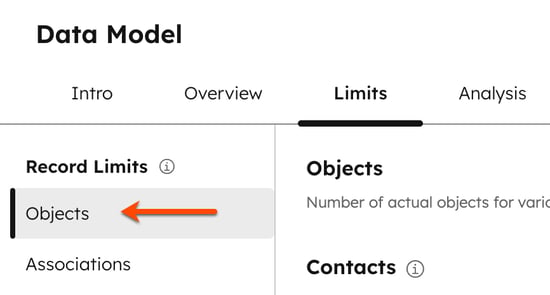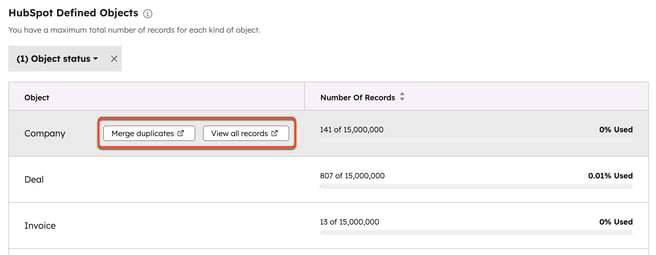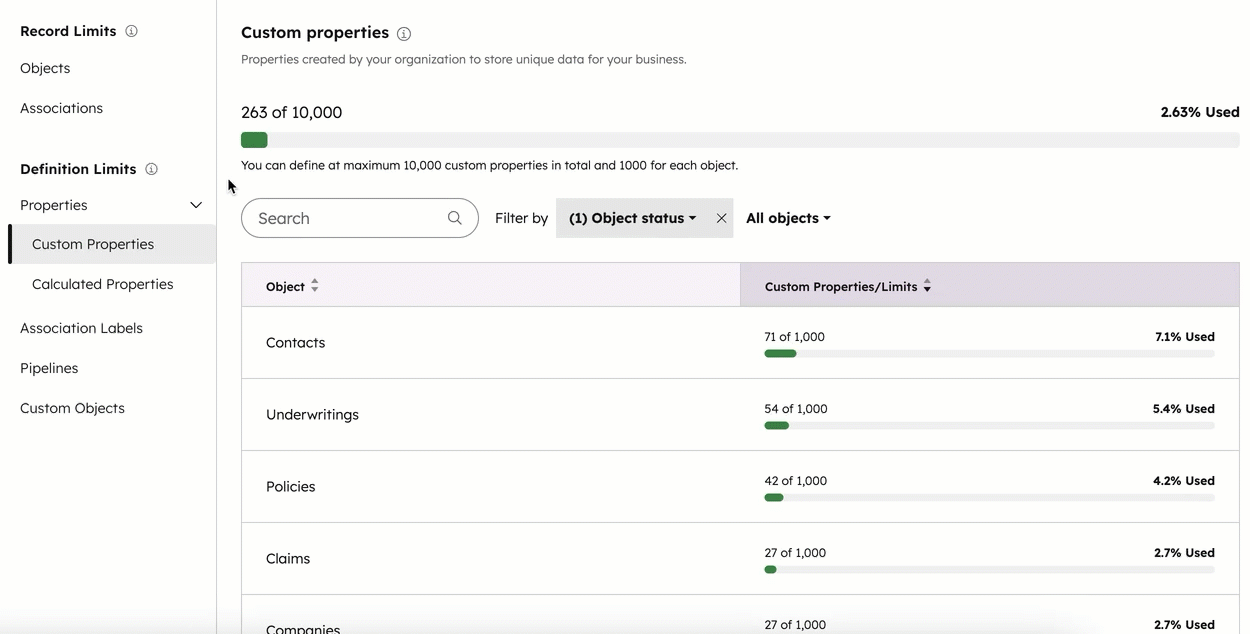- Knowledge Base
- Data
- Data Management
- Track your CRM data usage
Track your CRM data usage
Last updated: November 3, 2025
Available with any of the following subscriptions, except where noted:
-
Marketing Hub Starter, Professional, Enterprise
-
Sales Hub Starter, Professional, Enterprise
-
Service Hub Starter, Professional, Enterprise
-
Data Hub Starter, Professional, Enterprise
-
Content Hub Starter, Professional, Enterprise
-
Commerce Hub Professional, Enterprise
In the data model overview, you can keep track of your account's limits for storing CRM data. The Limits tab displays your usage limits for the following data:
- Records per object
- Associations
- Custom properties
- Pipelines per object
- Calculated properties (Professional and Enterprise only)
- Association labels (Professional and Enterprise only)
- Custom objects (Enterprise only)
Please note: the limits shown will depend on your HubSpot subscription. Learn more about your account's limits in the HubSpot Product & Services Catalog.
View CRM data usage and limits
To view your account's CRM data limits and usage:
- In your HubSpot account, navigate to Data Management > Data Model.
- Navigate to the Limits tab.
- In the left sidebar menu, click a data category to view the specific usage and limits for that data.

Records
In your HubSpot account, there are limits to the number of records you can store per object, as well as the number of records that can be associated with each other.
- To view the number of records stored per object, navigate to Objects in the left sidebar menu. In the table, view the number of records compared to the limit.
- To view all records for an object, hover over the row, then click View all records. You'll be brought to the object home page.
- To manage duplicate contact and company records (Professional and Enterprise only), hover over the row, then click Merge duplicates. You'll be brought to the duplicate management tool.

- To view high-usage associations, navigate to Associations in the left sidebar menu. Records will only be included in this view if they've reached 80% or more of their association limit.
- To view specific associations, click the Primary object and Associated object dropdown menus, then select the objects.
- To view a report of all records approaching or at the maximum limit for associations, click Download high usage report.
Learn more about associating records.
Properties
Depending on your HubSpot subscription, there's a limit to the number of custom properties you can create per object. If your account has a Professional or Enterprise subscription, you can also create a specific amount of calculation properties.
- To view the number of custom or calculated properties, navigate to Properties > [Custom/Calculated] Properties in the left sidebar menu.
- To filter the objects included, click the Filter by dropdown menu, then select the objects.
- To view all custom/calculated properties for an object, hover over the row, then click View all [custom/calculated] properties. You'll be brought to the property settings.

Learn more about creating properties.
Pipelines
Depending on your HubSpot subscription, there's a limit to the number of pipelines you can create per object. If your account has an Enterprise subscription, there's a limit to the number of custom object pipelines you can create across all custom objects, rather than per object.
- To view the number of pipelines per object, navigate to Pipelines in the left sidebar menu.
- To filter objects based on whether they're activated in your account, click the Object status dropdown menu and select Activated objects or Deactivated objects.
- To view the pipelines for an object, hover over the row, then click View the pipeline settings. You'll be brought to the pipeline settings for the selected object.
Association labels
Subscription required A Professional or Enterprise subscription is required to create custom association labels to define record relationships.
Create custom association labels to define record relationships. There are limits to the number of labels you can create for each relationship.
- To view the number of association labels per association type, navigate to Association Labels in the left sidebar menu.
- To filter specific object association types, click the From object and To object dropdown menus and select the objects.
- To view the labels in your association settings, hover over the row, then click Go to settings.
- To view labels in the data model overview, click the labels in the Custom association labels column. You'll be brought to the Association details page.
Learn more about creating and managing association labels.
Custom objects
Subscription required An Enterprise subscription is required to create custom objects.
You can view and create custom objects that you can then track.
- To view the number of defined custom objects, navigate to Custom Objects in the left sidebar menu.
- To view the custom object's settings, hover over the row, then click Go to settings.
Learn more about creating custom objects.